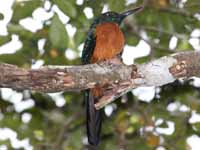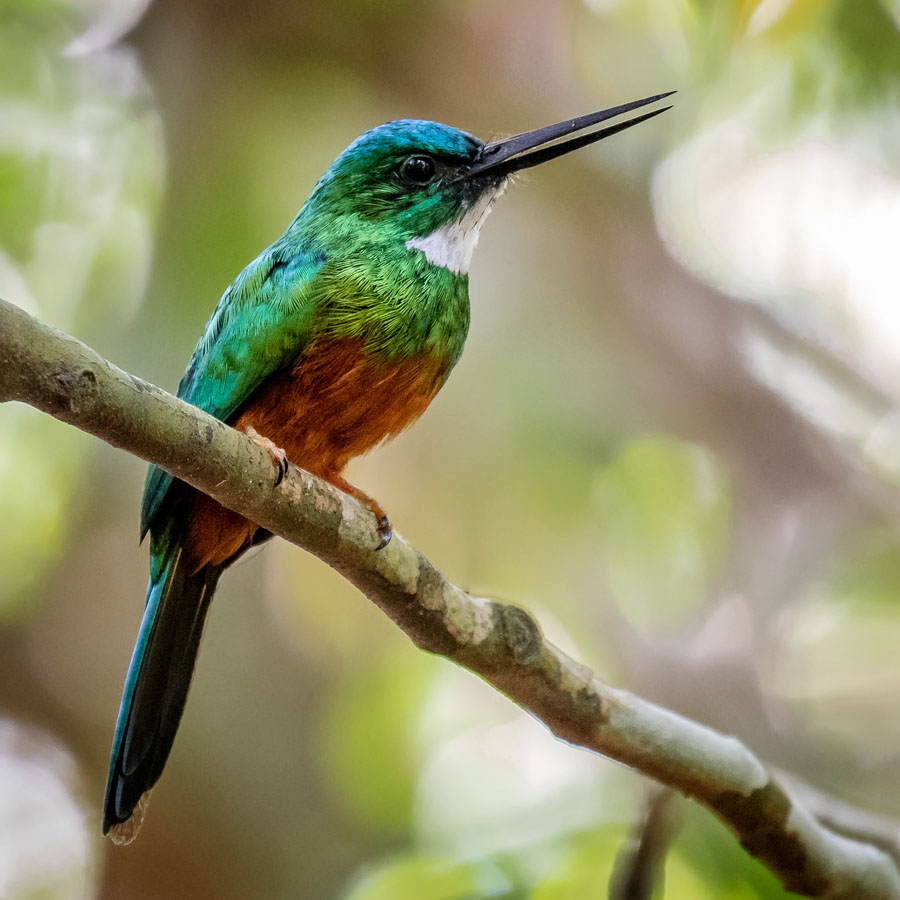Jacamars are found in Central and South America. There are 5 genera and 18 species
They are closely related to the puffbirds, another Neotropical family, and the two families are often separated into their own order, Galbuliformes, separate from the Piciformes. In general, the family members are faring well in their habitats. Only 2 of the 18 species are having major troubles: the tree-toed jacamar is listed as Near Threatened and the coppery-chested jacamar is listed as Vulnerable.
Jacamars are usually colorful plus have long tails and bills which produce a hummingbird type appearance, but the jacamars
live on insects, not nectar. They search for the insects from a perch in the tree and then catch them in flight. The sexes are similar in appearance, but males often have a white patch on the throat. Most jacamars are from 15 to 25 cm in length, which includes their long bill and tail. The paradise jacamar can reach 34 cm in length due to its very long tail. The great jacamar "only" gets to 30 cm long, but it is the heaviest jacamar, weighing up to 75 grams. Jacamar nests are mostly excavated in termine mounds that are located in trees or earthen bankings, especially stream or river banks.
Except for the three-toed jacamar, they have two toes forward and
two toes facing to the rear, like the rest of the piciformes. They are the only piciform family that has down feathers in the young.
Genus Brachygalba
Jacamar,_Brown Brachygalba lugubris
Range: The brown jacamar is found in northern South America east of the Andes: Bolivia, Brazil, Colombia, Ecuador, French Guiana, Guyana, Peru, Suriname, and Venezuela.
Habitat: Riverbanks with trees available. Also primary or secondary forests, treed savanna.
Diet: Insects which it catches in flight from a perch in a tree.
Conservation status: Least Concern.
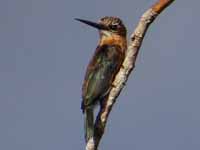
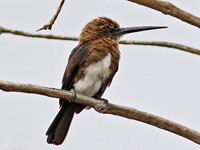
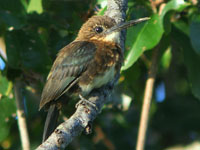
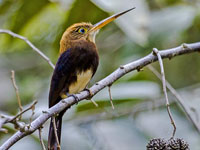
Jacamar, Dusky-backed Brachygalba salmoni
Range: Colombia and Panama.
Habitat: Forest edges, such as by clearings and along streams.
Diet: Insects which it catches in flight from a perch in a tree or bush.
Conservation status: Least Concern.
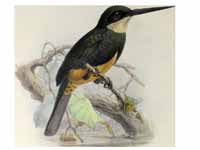
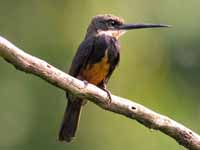
Jacamar,_Pale-headed Brachygalba goeringi
Range: Columbia. Venezuela.
Habitat: Primarily inhabits the edges of gallery and secondary forest in grasslands.
Diet: Insects which it catches in flight from a perch in a tree.
Conservation status: Least Concern.
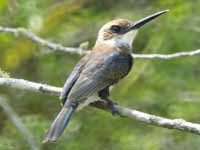
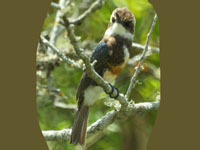
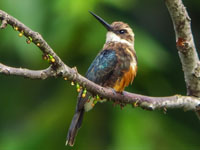
Jacamar, White-throated Brachygalba
Range: Eastern Peru, western Brazil, and northern Boliva.
Habitat: Edges of primary forest or young growth along whitewater rivers.
Diet: Insects which it catches in flight from a perch in a tree.
Conservation status: Least Concern.
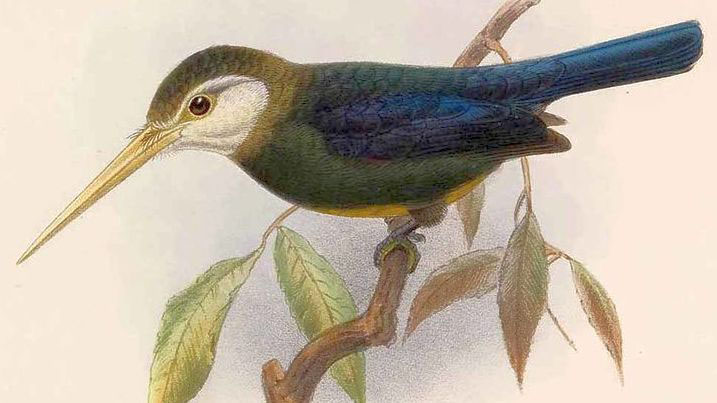
Genus Galbalcyrhynchus
Jacamar,_Purus Galbalcyrhynchus purusianus
Range: Eastern Peru, western Brazil, and northern Bolivia.
Habitat: Forest edges, near rivers.
Diet: Insects which it catches in flight from a perch in a tree.
Conservation status: Least Concern.

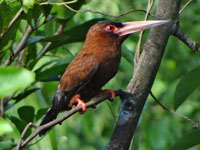
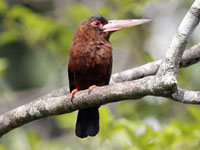
Jacamar,_White-eared Galbalcyrhynchus leucotis
Range: Brazil, Colombia, Ecuador, Peru.
Habitat: Forest edges and waterways.
Diet: Insects which it catches in flight from a perch in a tree.
Conservation status: Least Concern.
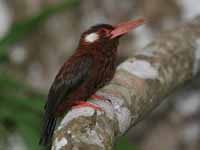

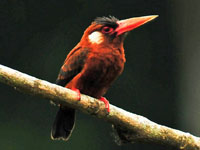
Genus Galbula
Some of these species excavate a nest-cavity in the ground while others in an termite mound which is located in a tree. They generally have green upperparts and black bills, except for the yellow-billed and blue-cheeked jacamars with yellow bills.
Jacamar,_Blue-cheeked Galbula cyanicollis Found: Bolivia, Brazil, and Peru.
Range: Eastern Peru, far northern Bolivia, and Brazil.
Habitat: Lowland evergreen forests.
Diet: : Insects which it catches in flight from a perch in a tree.
Conservation status: Least Concern.
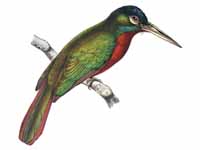

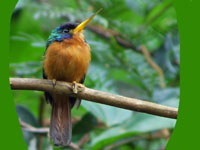
Jacamar,_Bluish-fronted Galbula cyanescens
Range: Bolivia, Brazil, Peru.
Habitat: Typically found in mid-stage succession vegetation along the forest edges and especially along watercourses and lakesides.
Diet: Insects which it catches in flight from a perch in a tree.
Conservation status: Least Concern.
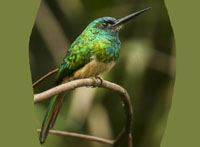
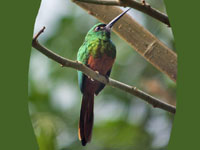

Jacamar,_Bronzy Galbula leucogastra
Range: South America, mainly north of the Amazon.
Habitat: Forest edges, along waterways.
Diet: Insects which it catches in flight from a perch in a tree.
.
Conservation status: Least Concern.
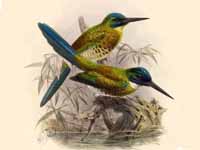
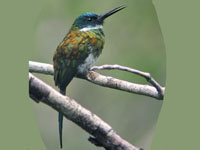
Jacamar,_Coppery-chested Galbula pastazae
Range: Colombia, Ecuador, Peru.
Habitat: Montane forest edges, openings, waterways.
Diet: Probably insects.
Conservation status: It is listed as Vulnerable because it is not common and the population seems to be deceasing because of deforestation.
1) Female

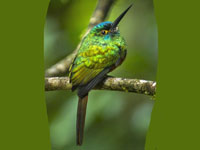
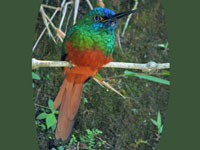
Jacamar,_Green-tailed Galbula galbula
Range: Brazil, Colombia, Guyana, Suriname, Venezuela.
Habitat: Open woodland, savanna, and shrublands, especially along watercourses.
Diet: Insects which it catches in flight from a perch in a tree.
Conservation status: Least Concern.
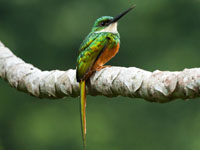
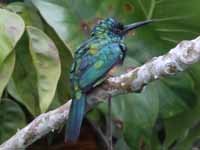
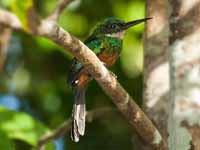
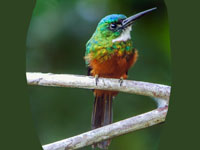
Jacamar,_Paradise Galbula dea
Range: Central and northern South America.
Habitat: The edges of primary and secondary forests, forest clearings. Unlike most jacamars, it is found high in the canopy instead of mid level.
Diet: Insects which it catches in flight from a perch in a tree.
Conservation status: Least Concern.

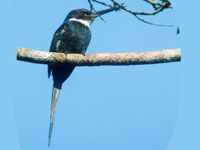
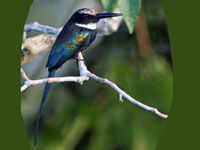
Jacamar,_Purplish Galbula chalcothorax
Range: Brazil, Colombia, Ecuador, Peru.
Habitat: Forests and their edges, along waterways.
Diet: Insects which it catches in flight from a perch in a tree.
Conservation status: Least Concern.
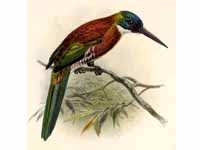

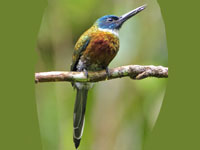
Jacamar,_Rufous-tailed Galbula ruficauda
Range: Central and South America.
Habitat: Forest edges, waterways, plantations.
Diet: Insects which it catches in flight from a perch in a tree.
Conservation status: Least Concern.
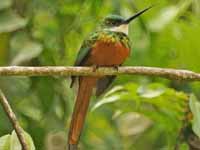
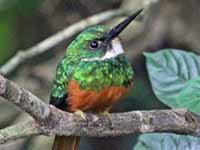
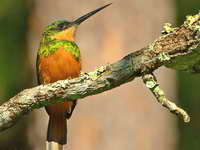
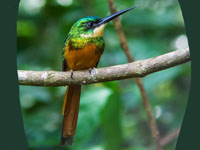
Jacamar,_White-chinned Galbula tombacea
Range: Brazil, Colombia, Ecuador, Peru.
Habitat: Shrubby borders and openings in forests, also along watercourses.
Diet: Insects which it catches in flight from a perch in a tree.
Conservation status: Least Concern.
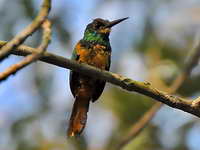
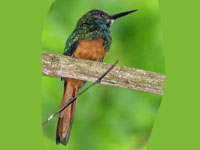
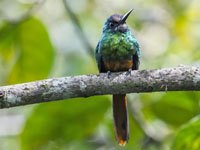
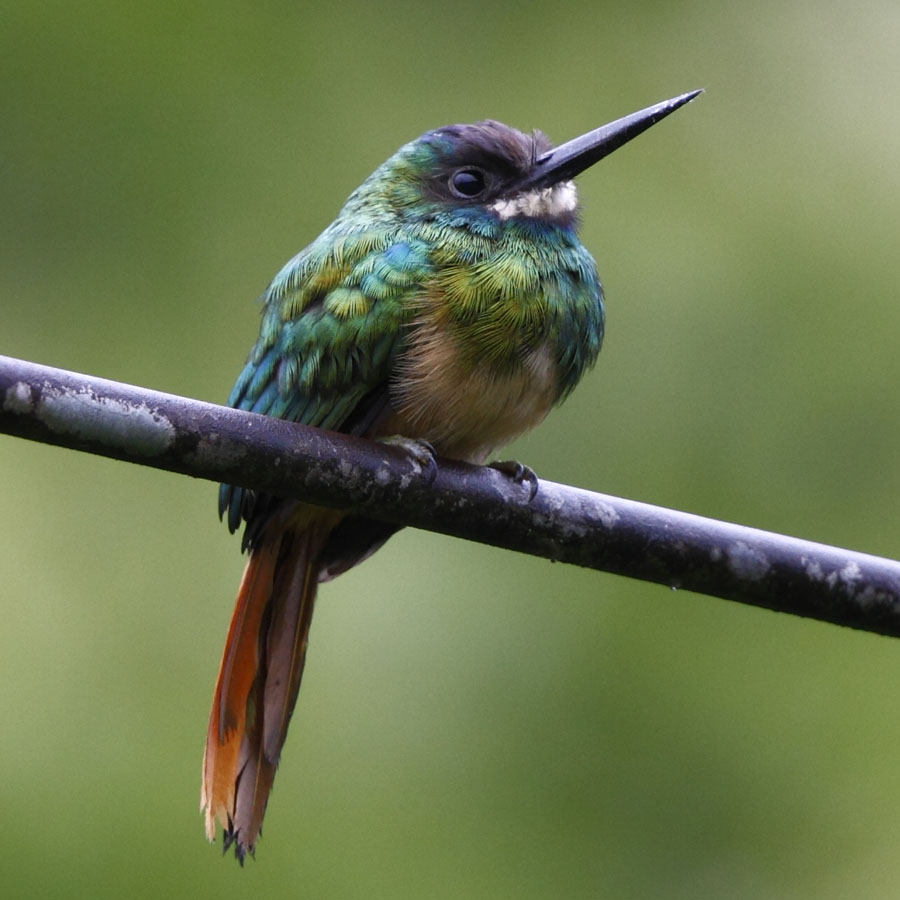
Jacamar,_Yellow-billed Galbula albirostris
Range: Northern Brazil, Colombia, Ecuador, , Guyana, Peru, Suriname, Venezuela.
Habitat: Forest interiors and edges.
Diet: Insects which it catches in flight from a perch in a tree.
Conservation status: Least Concern.
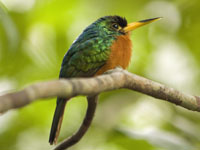
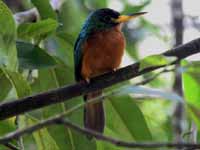
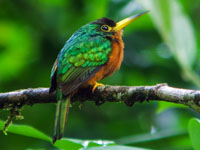
Genus Jacamaralcyon - 1 species
Jacamar,_Three-toed Jacamaralcyon tridactyla
Range: Southeastern Brazil.
Habitat: Drier parts of the Atlantic forest; also degraded forests.
Diet: Insects which it catches in flight from a perch in a tree.
Conservation status: It is listed as Near Threatened because of deforestation and degradation.
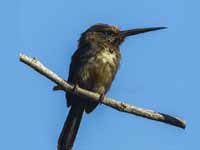
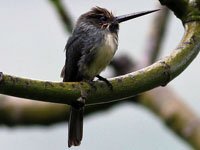
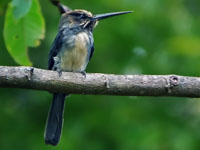
Genus Jacamerops - 1 species
Jacamar,_Great Jacamerops aureus
Range: Costa Rica to Bolivia and Brazil.
Habitat: Forests and their edges, along waterways.
Diet: Insects which it catches in flight from a perch in a tree; also gleans insects while one the tree.
Conservation status: Least Concern.

